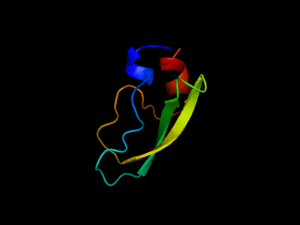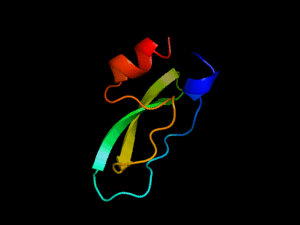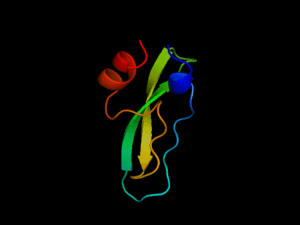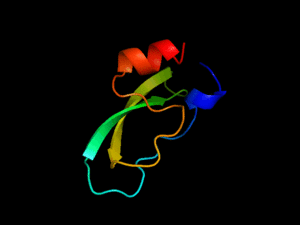Difference between revisions of "ASPA Normal Mode Analysis"
(→WebNM@) |
|||
| Line 1: | Line 1: | ||
==WebNM@== |
==WebNM@== |
||
| + | |||
| + | WebNM@ is a Normal Mode analysis tool developed by Hollup, Sælensminde and Reuter. It is one of the methods uses that only look at C_Alpha atoms. We ran it on our protein (PDB Code 2O53) using the default settings and using all chains. |
||
| + | |||
| + | These are the deformation energies computed by WebNM@: |
||
| + | <pre> |
||
| + | Mode Index Deformation Energy Mode Index Deformation Energy |
||
| + | 7 870.03 14 3740.78 |
||
| + | 8 976.54 15 4168.69 |
||
| + | 9 1562.41 16 5263.58 |
||
| + | 10 2800.99 17 5461.10 |
||
| + | 11 2798.65 18 5906.92 |
||
| + | 12 2954.75 19 6126.73 |
||
| + | 13 3448.49 20 6356.04</pre> |
||
| + | |||
| + | Since the actual energy of the protein is a composite of all the normal modes (after all, all of the motions happen simultaneously), comparing the energies is of little significance. What does meet the eye, however, is that there is a fairly steady increase of energy with higher normal mode numbers. |
||
| + | |||
| + | WebNM@ also generates atomic displacement charts. These indicate how much movement individual residues undergo in the various normal modes. |
||
| + | |||
| + | [[File:ASPA webnma displacement.png|600px|center]] |
||
| + | |||
| + | These are quite interesting in that they differ so strongly, yet there are quite a few places (around residue 100, 200) where almost all of the graphs show peaks to some degree. These seem to be regions that are very flexible. Mode 7 shows a rather strong cluster of peaks in between 350-400. This cluster is recognizable in Mode 8 and Mode 10 too, and to some degree in Mode 12. This seems to indicate a highly mobile region of the protein. We expected some kind of faint symmetry to be visible since we analyzed both domains, but there is none to be seen in the plots, which leads us to assume that this hypothesis is faulty. We also expected to see low mobility around the active site at 117 resp. 427; we found that this supposition holds. |
||
| + | |||
| + | Also returned was a graph of the fluctuations in position of the individual C Alpha atoms: |
||
| + | |||
| + | [[File:ASPA webnma fluctuations.png|500px|center]] |
||
| + | |||
| + | There seem to be two mobile regions, around ca. 80 and ca. 380, and a couple of more isolated peaks that we assume to denote local mobility e.g. of coils. It is interesting to see that the active site around 117 resp. 427 is in a region of very low mobility, as we would have expected to find. |
||
| + | |||
| + | Finally, animations of the individual movements for the Normal Modes: |
||
{| cellpadding="2" style="border: 0px;" align="center" |
{| cellpadding="2" style="border: 0px;" align="center" |
||
| Line 10: | Line 39: | ||
|[[File:canavan_webnma_anim12.gif |thumb|center|300px| WebNM@ Normal Mode 12]] |
|[[File:canavan_webnma_anim12.gif |thumb|center|300px| WebNM@ Normal Mode 12]] |
||
|} |
|} |
||
| − | |||
==ElNemo== |
==ElNemo== |
||
Revision as of 21:34, 30 August 2011
Contents
WebNM@
WebNM@ is a Normal Mode analysis tool developed by Hollup, Sælensminde and Reuter. It is one of the methods uses that only look at C_Alpha atoms. We ran it on our protein (PDB Code 2O53) using the default settings and using all chains.
These are the deformation energies computed by WebNM@:
Mode Index Deformation Energy Mode Index Deformation Energy 7 870.03 14 3740.78 8 976.54 15 4168.69 9 1562.41 16 5263.58 10 2800.99 17 5461.10 11 2798.65 18 5906.92 12 2954.75 19 6126.73 13 3448.49 20 6356.04
Since the actual energy of the protein is a composite of all the normal modes (after all, all of the motions happen simultaneously), comparing the energies is of little significance. What does meet the eye, however, is that there is a fairly steady increase of energy with higher normal mode numbers.
WebNM@ also generates atomic displacement charts. These indicate how much movement individual residues undergo in the various normal modes.
These are quite interesting in that they differ so strongly, yet there are quite a few places (around residue 100, 200) where almost all of the graphs show peaks to some degree. These seem to be regions that are very flexible. Mode 7 shows a rather strong cluster of peaks in between 350-400. This cluster is recognizable in Mode 8 and Mode 10 too, and to some degree in Mode 12. This seems to indicate a highly mobile region of the protein. We expected some kind of faint symmetry to be visible since we analyzed both domains, but there is none to be seen in the plots, which leads us to assume that this hypothesis is faulty. We also expected to see low mobility around the active site at 117 resp. 427; we found that this supposition holds.
Also returned was a graph of the fluctuations in position of the individual C Alpha atoms:
There seem to be two mobile regions, around ca. 80 and ca. 380, and a couple of more isolated peaks that we assume to denote local mobility e.g. of coils. It is interesting to see that the active site around 117 resp. 427 is in a region of very low mobility, as we would have expected to find.
Finally, animations of the individual movements for the Normal Modes:
ElNemo
Anisotropic Network Model web server
NOMAD-ref


















































